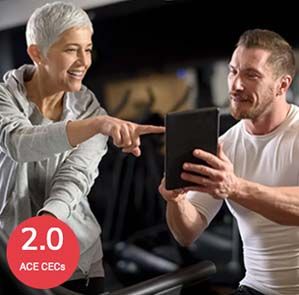Ask ACE: How to Maximize AI to Grow Your Career

In this series, ACE experts answer your health and exercise questions. From nutrition to youth fitness, you’ll find detailed answers to many of the questions that may come up in your work with clients. If you have questions you’d like to ask our experts, please email us at Christine.Ekeroth@acefitness.org.

The Expert: Ted Vickey, PhD, is the ACE senior consultant for emerging technologies and a long-time ACE Certified Personal Trainer. Referred to as “one of the most connected men in fitness,” Vickey served as executive director of the White House Athletic Center under three presidents before starting FitWell Inc., a fitness management consulting company.
Q: There is so much talk about how AI can be used for just about anything, but I’m not sure where to start. Can I use it for creating workouts for my clients? And if so, how can I be sure to use it ethically and with safeguards for client safety?
A: Using AI, like ChatGPT, in fitness isn’t just about crunching numbers or managing schedules. It’s about diving deep into the latest research without getting lost in the jargon. Think of it as having a super-smart exercise science buddy who is always up to date with the newest research but explains it to you over a casual coffee chat.
This tech is also a game-changer for creating workouts that click with clients. By understanding their likes, needs and fitness goals (all of which you can add to your prompts based on feedback from your clients), AI helps us design personalized programs that are simply more fun and effective. It’s like crafting a fitness playlist that perfectly vibes with each client’s taste and mood.
And here’s the kicker: AI doesn’t just stop at improving our clients’ experiences. It gives us, the fitness pros, a leg up in refining how we coach. We can tweak our approach by picking up on what motivates our clients and keeps them coming back, making every session more engaging. It’s all about making the fitness journey as rewarding for them as it is for us.
Before incorporating ChatGPT into your fitness toolbox, however, it is essential to consider safeguards for you and your clients and ensure you maintain your ethics as a health and exercise professional.
Here are some ideas on best practices for using AI. First, remember to keep things anonymous. Just like you wouldn’t shout someone’s personal data across the fitness center floor, don’t let those details slip when chatting with ChatGPT. It’s all about making sure that any client stories you share with it don’t include names or identifying content. Be creative and use fictional names—you can simply use a fake name or create a naming system that works for you. Also, be upfront with your clients that you use ChatGPT as a tool, much like a treadmill or dumbbell that you are using to enhance the value of the services you offer.
Using ChatGPT’s genius responsibly means using it to boost what you already know and tweaking that knowledge to improve it even more. It’s like having a brainstorm buddy who never gets tired. Whether cooking up fresh workout routines or cutting down on paperwork, AI tools like ChatGPT make our lives easier. But remember, it’s the human touch that tailors everything perfectly to each client.
Q: I’ve been trying to use ChatGPT for a while, but I can’t seem to get the results that other people keep raving about. I’ve read that using the right prompts is really important, but I’m not sure how to do that.
A: Navigating the world of ChatGPT prompts is like learning the best ways to communicate with a new client. It’s all about figuring out how to ask the right questions that will help them identify what they really want to achieve.
Think of it this way: The prompts are like your workout plan for ChatGPT. Just as you wouldn’t advise a client to jump into a heavy-lifting session without a plan, you don’t want to dive into ChatGPT without a clear idea of your goal.
Your goal is a great place to start. Are you looking to generate new workout ideas, elevate your nutrition advice or automate those time-consuming admin tasks?
Now, imagine explaining this goal to a mentor who is keen to help but needs the whole picture to give you the best advice. You wouldn’t just say, “I want to make more money.” Rather, you’d be much more specific and say something like, “I want to raise my fees by 10% over the next year without alienating or angering my long-standing clients.” Apply the same approach with ChatGPT. Be clear, detailed and, most importantly, specific about your request.
Here’s a pro tip: Keep your prompts conversational but focused. ChatGPT loves this. Try something like “Hey, can you help me draft a four-week strength-training program for beginners that focuses on body-weight exercises? And throw in some tips for those working out at home.”
And just like in the gym, where we learn and adapt, don’t be afraid to refine your prompts based on what works. It’s a bit of trial and error to find that sweet spot.
Always remember the golden rule of coaching: Keep learning. The better you get at crafting these prompts, the more you’ll get out of ChatGPT. It’s all about enhancing your coaching toolkit, one prompt at a time.
By the way, I named my ChatGPT Jarvis after my favorite superhero, Ironman. I greet him every morning and he responds with a dad joke to start my day with a smile.
Q: I know that there are free and paid options for ChatGPT. What is the difference? Is it worth spending the extra money to have the paid option?
A: The differences between the free and paid versions of ChatGPT can significantly impact your workflow and client interactions. The free version traditionally used GPT-3.5, which is capable but less sophisticated in understanding complex queries and providing detailed, context-aware responses. This version is suitable for basic inquiries and generating straightforward content.
With the introduction of GPT-4o, the free version now includes several upgrades, such as faster performance, multimodal capabilities across text, voice and vision, and the ability to upload and analyze images and documents. These features, which were previously exclusive to paid users, greatly enhance the utility of the free version. For example, you can now use GPT-4o to get detailed summaries of research papers or to assist with visual content, such as identifying plants or solving math equations from photos. Perhaps soon, it will even be able to view a video of a person exercising and determine if they are using the proper form.
The paid version, ChatGPT Plus, continues to offer advantages such as higher usage limits, priority access to GPT-4o, and additional features like a new macOS app. This can be crucial for creating personalized training plans, motivational content and handling complex fitness questions. The improved Voice Mode in GPT-4o, which allows for more natural and contextual voice interactions, can also be particularly useful if you need real-time assistance or translations.
In my opinion, the upgrade to GPT-4o in the free version provides substantial improvements, making it highly beneficial even without a subscription. However, for those who require the highest level of performance and additional features, investing in the paid option can still be worthwhile for its enhanced capabilities and priority access.
One more thing to keep in mind: ChatGPT isn’t connected to the internet when it is whipping up answers. Rather, think of it as having a massive library of fitness books in its head that contains everything it learned up to its last update in April 2023. Future “training” will take place as time goes on. So, while it can’t grab the latest health trends or research directly from the web in real-time, it’s still pretty savvy thanks to the massive amount of knowledge it contains. If you need your AI to be connected to the internet, check out the Google or Microsoft AI tools.
Q: I’m a huge ChatGPT fan and use it all the time for my business, but I’m starting to worry that I’m relying on it too much. Are there any serious downsides to using AI tools like ChatGPT for just about everything?
A: Isn’t there a risk in relying on anything too much? The same is true with ChatGPT. Let’s look at what ChatGPT can do to help you work smarter, not harder, as a health and exercise professional, especially regarding time management. After all, there are only so many hours in the day, and you want to spend as much time as possible doing what you love: coaching and connecting with your clients. Here’s where ChatGPT steps in, taking on those tasks that, let’s be honest, we’d rather not do or simply eat up too much of our valuable time. Things like admin tasks—we all have them, and we all wish we didn’t. Emailing, scheduling and client follow-ups—ChatGPT can handle these like a pro. Imagine not having to spend hours in your inbox or figuring out your schedule for the week. Instead, ChatGPT can draft those emails, set up appointments and even send out reminders for you. This means more time for face-to-face interactions with your clients, focusing on their progress and truly being present.
Then there’s program planning. While nothing beats the personalized touch you bring to creating workout plans, ChatGPT can offer a solid starting point. Give it your client’s goals, preferences and any special considerations; it can whip up a customized plan in no time. This doesn’t replace your expertise but gives you a foundation to build on, tweak and perfect. It’s about using AI to enhance your efficiency, not replace your role.
ChatGPT is here to handle the grunt work—the scheduling, the emailing, the initial drafting of plans and even research. This frees you up to invest more time in what truly matters: those one-on-one moments with your clients that make all the difference. It’s about working smarter and letting technology take on the load so you can focus on inspiring and motivating your clients to achieve their best.
Expand Your Knowledge
AI Bootcamp for Health and Fitness Coaches
If you are a tech-savvy coach eager to enhance service delivery and efficiency, this self-paced online course is for you. Gain a competitive edge by using AI as a coaching simulator, receiving personalized feedback on client interactions, and implementing improvements for future engagements. This virtual assistant not only aids in marketing and content creation but also elevates the overall coaching experience, enabling you to serve your clients more effectively and advance your career. With unique, highly practical features like simulated client interactions and feedback analysis, you’ll gain insights from both coaching and technical/marketing experts.
More Articles
- Certified™: June 2024
The Best Investments to Make in Your Career Right Now
Contributor
- Certified™: June 2024
Weight Focused vs. Weight Neutrality: How to Find the Balance Between Two Extremes
- Certified™: June 2024
Make an Impact With Appreciative Inquiry and Coaching
Contributor
- Certified™: June 2024







